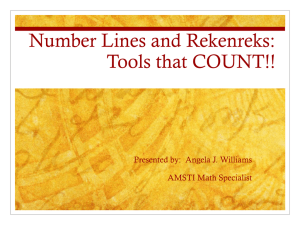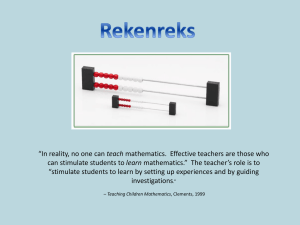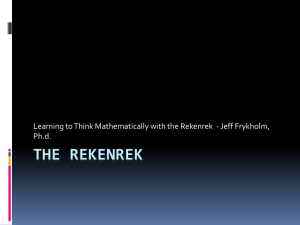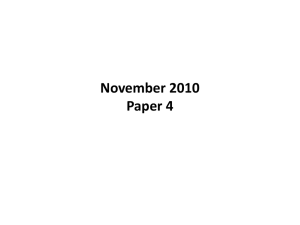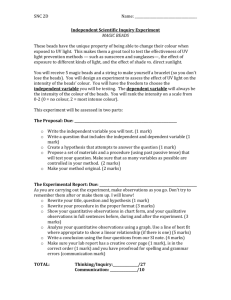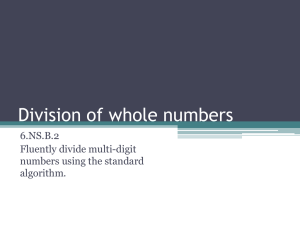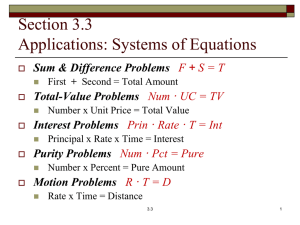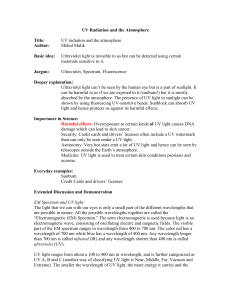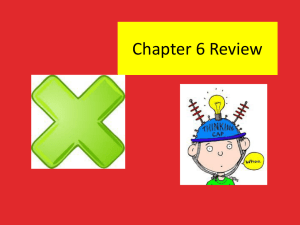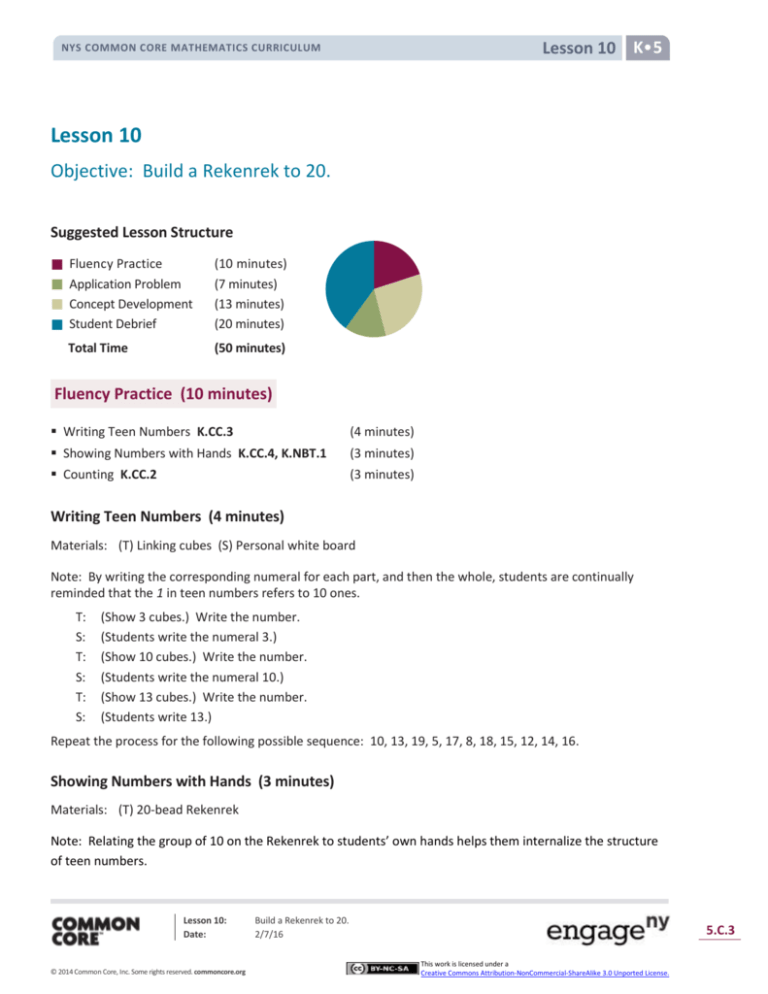
Lesson 10 K•5
NYS COMMON CORE MATHEMATICS CURRICULUM
Lesson 10
Objective: Build a Rekenrek to 20.
Suggested Lesson Structure
Fluency Practice
Application Problem
Concept Development
Student Debrief
Total Time
(10 minutes)
(7 minutes)
(13 minutes)
(20 minutes)
(50 minutes)
Fluency Practice (10 minutes)
Writing Teen Numbers K.CC.3
(4 minutes)
Showing Numbers with Hands K.CC.4, K.NBT.1
(3 minutes)
Counting K.CC.2
(3 minutes)
Writing Teen Numbers (4 minutes)
Materials: (T) Linking cubes (S) Personal white board
Note: By writing the corresponding numeral for each part, and then the whole, students are continually
reminded that the 1 in teen numbers refers to 10 ones.
T:
S:
T:
S:
T:
S:
(Show 3 cubes.) Write the number.
(Students write the numeral 3.)
(Show 10 cubes.) Write the number.
(Students write the numeral 10.)
(Show 13 cubes.) Write the number.
(Students write 13.)
Repeat the process for the following possible sequence: 10, 13, 19, 5, 17, 8, 18, 15, 12, 14, 16.
Showing Numbers with Hands (3 minutes)
Materials: (T) 20-bead Rekenrek
Note: Relating the group of 10 on the Rekenrek to students’ own hands helps them internalize the structure
of teen numbers.
Lesson 10:
Date:
© 2014 Common Core, Inc. Some rights reserved. commoncore.org
Build a Rekenrek to 20.
2/7/16
5.C.3
This work is licensed under a
Creative Commons Attribution-NonCommercial-ShareAlike 3.0 Unported License.
Lesson 10 K•5
NYS COMMON CORE MATHEMATICS CURRICULUM
T:
T:
S:
(Show 12 on the Rekenrek.)
Show the two parts of the number on your fingers. Say the parts at the same time.
10 (flashing ten fingers) and 2 (showing two fingers).
Continue with the following possible sequence: 13, 14, 19, 16, 18, 15, 11, 17, 20.
Counting (3 minutes)
Materials: (T) 20-bead Rekenrek
Note: Students relate Say Ten counting to conventional teen number names in this activity. Counting both
ways, and in both directions, ensures that students remain alert to the sequence and do not simply extend a
pattern of number words. If students struggle, return to a more manageable range (such as within 13 or 15),
and later build up to work within 20.
Count by ones from 11–20, changing directions both the Say Ten Way and the regular way.
Application Problem (7 minutes)
Ms. Garcia is painting her fingernails. She has painted all the
nails on her left hand except her thumb. How many more nails
does she need to paint? How many will she have left to paint
after she paints her left thumb? Draw a picture to help you.
Note: This problem is an application of K.OA.4, wherein
students learn the number that makes 10 from any number less
than 10. As a word problem, this is a change unknown, which is
a Grade 1 problem type. Therefore, the number sentence is not
asked for since missing addends will be introduced in the fall of
Grade 1.
Concept Development (13 minutes)
Materials: (S) Problem Set, 10 red beads, 10 white beads, a red
crayon, a black crayon
T:
T:
S:
(Distribute the Problem Set. Have the students put the
beads on the circles below the first pair of hands, 5 red
on the left, and 5 white on the right.)
Imagine these red beads are Ms. Garcia’s painted
fingernails. Show me how many she painted at first (in
the Application Problem). Put them on her fingernails.
(Move 4 beads from the circles to the fingernails,
starting with the left pinky finger.)
Lesson 10:
Date:
© 2014 Common Core, Inc. Some rights reserved. commoncore.org
NOTES ON
MULTIPLE MEANS
OF ENGAGEMENT:
Push the thinking of students working
above grade level by asking, “What
would happen if Ms. Garcia also paints
her toenails? How many nails will be
painted when she is completely done?”
Consider extending their thinking
further by asking, “If Ms. Garcia draws
two green polka dots on each finger,
how many polka dots does she paint all
together?”
Build a Rekenrek to 20.
2/7/16
5.C.4
This work is licensed under a
Creative Commons Attribution-NonCommercial-ShareAlike 3.0 Unported License.
NYS COMMON CORE MATHEMATICS CURRICULUM
T:
T:
S:
T:
S:
How many fingernails did she paint, and how many
does she need to paint? Use these words to help.
Listen.
“She painted ____ fingernails. She needs to paint
____ fingernails.”
She painted 4. She needs to paint 6.
Paint one more nail on her left hand. (Pause.) Tell me
what she’s painted and what she needs to paint.
She painted 5. She needs to paint 5.
Continue the pattern of painting one more fingernail and
making the statements that describe how many have been
painted and need to be painted. Have the students work
MP.7
independently as soon as they can. Once they have
finished the first pair of hands, have them use the second
pair of hands for Ms. Garcia’s daughter’s unpainted nails.
Have them put the beads on her fingers, counting and
making statements as they go. Engage them in counting
all the beads, analyzing how many are red and how many
are white, how many are on the left hands, and how many
on the right hands.
Lesson 10 K•5
NOTES ON
MULTIPLE MEANS
OF ACTION AND
EXPRESSION:
Scaffold the lesson for English language
learners by pointing to the painted
hand and asking, “How many did she
paint?” Then, point to the hand that is
not painted and ask, “How many does
she need to paint?”
Problem Set (5 minutes)
Students color the left-hand fingernails red and color the
right-hand fingernails black (in lieu of white), counting as
they go. They color the corresponding beads below to
match the hands, counting as they go. They can write
their numbers 1 to 10, too.
Student Debrief (20 minutes)
Lesson Objective: Build a Rekenrek to 20.
The Student Debrief is intended to invite reflection and
active processing of the total lesson experience.
Invite students to review their solutions for the Problem Set. They should check work by comparing answers
with a partner before going over answers as a class. They can count on or count all, as needed. Look for
misconceptions or misunderstandings that can be addressed in the Debrief. Guide students in a conversation
to debrief the Problem Set and process the lesson. Any combination of the questions below may be used to
lead the discussion.
Materials: (S) 10 red and 10 white pony beads from the Concept Development, two 12-inch lengths of elastic,
1 piece 2.75 inch by 5.5 inch chip board (or cardboard strip) with an indentation (note that each 8
½ inch by 11-inch chipboard makes 4 Rekenreks.)
Lesson 10:
Date:
© 2014 Common Core, Inc. Some rights reserved. commoncore.org
Build a Rekenrek to 20.
2/7/16
5.C.5
This work is licensed under a
Creative Commons Attribution-NonCommercial-ShareAlike 3.0 Unported License.
NYS COMMON CORE MATHEMATICS CURRICULUM
T:
T:
S:
T:
S:
T:
S:
Lesson 10 K•5
Let’s make a Rekenrek. Put your red beads on top of your red dots and your white beads on top of
your black dots, counting as you go.
What do you know about the number of your red and
white beads?
They both have ten. They are the same number.
They are an equal number.
How do you say the total number of beads the Say Ten
Way?
2 tens.
How many beads is that the regular way?
Twenty.
After showing students how to thread the elastic through from left to right, red beads first, give each student
a 12-inch elastic. Once they have finished one row, have them do the other row. Show them how to pinch
the elastics at either end to pick up the row and place it on their chip board (or cardboard strip), one row
under the other. The teacher can circulate and tie the elastics, or have helpers tie the elastics after class for
use in future lessons.
The discussion should establish a correlation between students’ fingernails and the beads of the Rekenrek.
Talk to your partner about what is the same and what is different about the number of your
fingernails and the number of beads.
How many people do we need to have the same number of fingernails as on your Rekenrek?
If the beads were purple and green, how many nails and beads would be purple, and how many
would be green?
What if you hide two hands? How many beads would you see?
Exit Ticket (3 minutes)
After the Student Debrief, instruct students to complete the Exit Ticket. A review of their work will help with
assessing students’ understanding of the concepts that were presented in today’s lesson and planning more
effectively for future lessons. The questions may be read aloud to the students.
Lesson 10:
Date:
© 2014 Common Core, Inc. Some rights reserved. commoncore.org
Build a Rekenrek to 20.
2/7/16
5.C.6
This work is licensed under a
Creative Commons Attribution-NonCommercial-ShareAlike 3.0 Unported License.
NYS COMMON CORE MATHEMATICS CURRICULUM
Name
Lesson 10 Problem Set K•5
Date
Lesson 10:
Date:
© 2014 Common Core, Inc. Some rights reserved. commoncore.org
Build a Rekenrek to 20.
2/7/16
5.C.7
This work is licensed under a
Creative Commons Attribution-NonCommercial-ShareAlike 3.0 Unported License.
NYS COMMON CORE MATHEMATICS CURRICULUM
Name
Lesson 10 Exit Ticket K•5
Date
Use your red crayon and yellow crayon to draw the beads from your
Rekenrek in two lines.
How many beads did you draw?
Trace your hands. Draw your fingernails. How many fingernails do you
have on your two hands?
Lesson 10:
Date:
© 2014 Common Core, Inc. Some rights reserved. commoncore.org
Build a Rekenrek to 20.
2/7/16
5.C.8
This work is licensed under a
Creative Commons Attribution-NonCommercial-ShareAlike 3.0 Unported License.
NYS COMMON CORE MATHEMATICS CURRICULUM
Name
Lesson 10 Homework K
Date
Color the number of fingernails and beads to match the number bond. Show
by coloring 10 ones above and extra ones below. Fill in the number bonds.
13
14
11
12
14
16
Lesson 10:
Date:
© 2014 Common Core, Inc. Some rights reserved. commoncore.org
17
Build a Rekenrek to 20.
2/7/16
5.C.9
This work is licensed under a
Creative Commons Attribution-NonCommercial-ShareAlike 3.0 Unported License.

